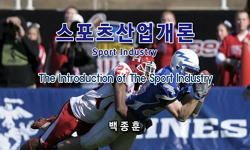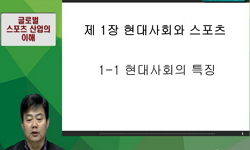Sports, indispensible for talking about the modern Japanese society, were introduced in Japan with other Western civilizations in the process of the modernization as part of the Meiji Restoration. During the Meiji period, sports were utilized as part ...
http://chineseinput.net/에서 pinyin(병음)방식으로 중국어를 변환할 수 있습니다.
변환된 중국어를 복사하여 사용하시면 됩니다.
- 中文 을 입력하시려면 zhongwen을 입력하시고 space를누르시면됩니다.
- 北京 을 입력하시려면 beijing을 입력하시고 space를 누르시면 됩니다.

1930年、競技場の中の身体を描くということ - 阿部知二「スポーツ小説」の可能性を問う - = What it Means to Represent the Body in the Stadium in 1930 - Exploring the Potential of the ‘Sports Novel’ of Tomoji Abe -
한글로보기https://www.riss.kr/link?id=A104880276
-
저자
장유리 (경북대학교)

- 발행기관
- 학술지명
- 권호사항
-
발행연도
2017
-
작성언어
Japanese
-
주제어
スポーツ、阿部知二、スポーツ小説、競技場、身体 ; 스포츠 ; 아베 도모지 ; 스포츠 소설 ; 경기장 ; 신체 ; sports ; Tomoji Abe ; sports novel ; stadium ; body
-
등재정보
KCI등재
-
자료형태
학술저널
- 발행기관 URL
-
수록면
385-404(20쪽)
-
KCI 피인용횟수
3
- DOI식별코드
- 제공처
- 소장기관
-
0
상세조회 -
0
다운로드
부가정보
다국어 초록 (Multilingual Abstract)
First of all, I tried to figure out the meaning of the sports in the Japanese cultural history by studying the modern Japanese sports changed with the period according to the passage of the time. Furthermore, on the basis of this result, I tried to study the potential that ‘the sports novel’ had as a new literary genre during the early Showa period by analyzing the stadium and the body represented in the stadium depicted in Tomoji Abe’s sports novel.
Sports, indispensible for talking about the modern Japanese society, were introduced in Japan with other Western civilizations in the process of the modernization as part of the Meiji Restoration. During the Meiji period, sports were utilized as part of the education to cultivate ‘the people’ suitable for the modern nation. From the Taisho period to the Showa period, however, sports gained popularity as a cultural object. With the rise of the public and the development of the media, people enjoyed sports not only through direct experience with them but also in the form of entertainment, and sports played an important role in the construction of the Japanese modern culture. This shift in the meaning of the sports has something to do with a place, the stadium.
First of all, I tried to figure out the meaning of the sports in the Japanese cultural history by studying the modern Japanese sports changed with the period according to the passage of the time. Furthermore, on the basis of this result, I tried to study the potential that ‘the sports novel’ had as a new literary genre during the early Showa period by analyzing the stadium and the body represented in the stadium depicted in Tomoji Abe’s sports novel.
다국어 초록 (Multilingual Abstract)
近代日本社会について言及する際に欠かせない存在であるといえるスポーツは、明治維新によって近代化が進められる中、他の西欧文明と共に日本へ入ってきた。明治時代には近代国家...
近代日本社会について言及する際に欠かせない存在であるといえるスポーツは、明治維新によって近代化が進められる中、他の西欧文明と共に日本へ入ってきた。明治時代には近代国家に相応しい「国民」を養成するための教育の一環として活用されたスポーツは、大正から昭和にかけて大衆文化として位置づけられるようになる。大衆の台頭とメディアの発達が相俟って、直接的な体験によってのみならず観る․聞く行為によっても営為されるようになったことで、スポーツは昭和初期に大衆の娯楽として流行し、日本のモダン文化において重要な役割を果たしたといえる。そして、そのようなスポーツの意味合いにおける変化の中心には競技場という場所があった。 本稿では、まず近代日本において時代と共に変化していったスポーツの様相について時間軸に沿って考察し、日本文化史におけるスポーツの意味合いを捉えることを試みる。そしてその結果を踏まえた上で、阿部知二の「スポーツ小説」に現れている競技場という空間と競技場の中に表れている身体について分析することで、昭和初期の新たな文学ジャンルとして「スポーツ小説」が保持していた可能性を究明することを本稿の目的とする。
참고문헌 (Reference)
1 김옥희, "일본 모더니즘문학의 소재로서의 스포츠" 일본연구소 (36) : 177-194, 2014
2 김옥희, "일본 근대문학과 스포츠" 소명출판 2012
3 阿部知二, "阿部知二全集 第1巻" 河出書房新社 64-72, 1974
4 권학준, "近代日本における「国民」形成と兵式体操に関する一考察" 일본어문학회 (49) : 385-406, 2010
5 冨田玲子, "近代文学にみられる身体観(3)─阿部知二『日独対抗競技』─" 千葉県立衛生短期大学 10 (10): 175-179, 1991
6 国文学編集部, "知っ得 明治․大正․昭和 風俗文化誌" 學燈社 144-145, 2007
7 平林初之輔, "平林初之輔遺稿集" 平凡社 223-238, 1932
8 권학준, "帝國日本의 國家戰略에 대한 일고찰" 일본어문학회 (28) : 319-344, 2005
9 権学俊, "国民体育大会の研究―ナショナリズムとスポーツ․イベント" 青木書店 1-437, 2006
10 夏目漱石, "吾輩は猫である" 新潮文庫 301-, 2014
1 김옥희, "일본 모더니즘문학의 소재로서의 스포츠" 일본연구소 (36) : 177-194, 2014
2 김옥희, "일본 근대문학과 스포츠" 소명출판 2012
3 阿部知二, "阿部知二全集 第1巻" 河出書房新社 64-72, 1974
4 권학준, "近代日本における「国民」形成と兵式体操に関する一考察" 일본어문학회 (49) : 385-406, 2010
5 冨田玲子, "近代文学にみられる身体観(3)─阿部知二『日独対抗競技』─" 千葉県立衛生短期大学 10 (10): 175-179, 1991
6 国文学編集部, "知っ得 明治․大正․昭和 風俗文化誌" 學燈社 144-145, 2007
7 平林初之輔, "平林初之輔遺稿集" 平凡社 223-238, 1932
8 권학준, "帝國日本의 國家戰略에 대한 일고찰" 일본어문학회 (28) : 319-344, 2005
9 権学俊, "国民体育大会の研究―ナショナリズムとスポーツ․イベント" 青木書店 1-437, 2006
10 夏目漱石, "吾輩は猫である" 新潮文庫 301-, 2014
11 中村三春, "修辞的モダニズム-テクスト様式論の試み-" ひつじ書房 189-245, 2006
12 和田博文, "テクストとしてのモダン都市" 風媒社 199-, 1999
13 高津勝, "スポーツ社会学の可能性―歴史․身体․社会を探る" 創文企画 1-294, 2008
14 大宅壮一, "スポーツとしての恋愛" 新潮社 28 (28): 10-14, 1931
15 西山康一, "スポーツする文学─1920-30年代の文化詩学" 青弓社 80-102, 2009
16 阿部知二, "スポオツ小説のこと" 天人社 1 (1): 34-, 1930
17 中村三春, "コレクション․モダン都市文化第9卷競技場" ゆまに書房 665-718, 2005
18 加賀秀雄, "わが国における近代国家の展開と国家のスポーツ政策" 日本体育学会 44 : 128-132, 1999
19 加賀秀雄, "1930年前後のわが国におけるスポーツ動向とその歴史的性格について" 名古屋文理大学 (1) : 129-, 2001
동일학술지(권/호) 다른 논문
-
- 일본어문학회
- 공미희(Kong Mi Hee)
- 2017
- KCI등재
-
- 일본어문학회
- 琴鍾愛(Keum Jong Ae)
- 2017
- KCI등재
-
『縮み志向の日本人』과 『축소지향의 일본인』에 나타나는 후치사 용법 고찰
- 일본어문학회
- 김선희(Kim Sun Hee)
- 2017
- KCI등재
-
- 일본어문학회
- 김양선(Kim Yang Sun)
- 2017
- KCI등재
분석정보
인용정보 인용지수 설명보기
학술지 이력
| 연월일 | 이력구분 | 이력상세 | 등재구분 |
|---|---|---|---|
| 2026 | 평가예정 | 재인증평가 신청대상 (재인증) | |
| 2020-01-01 | 평가 | 등재학술지 유지 (재인증) |  |
| 2017-01-01 | 평가 | 등재학술지 유지 (계속평가) |  |
| 2013-01-01 | 평가 | 등재학술지 유지 (등재유지) |  |
| 2010-01-01 | 평가 | 등재학술지 유지 (등재유지) |  |
| 2008-01-01 | 평가 | 등재학술지 유지 (등재유지) |  |
| 2005-01-01 | 평가 | 등재학술지 선정 (등재후보2차) |  |
| 2004-01-01 | 평가 | 등재후보 1차 PASS (등재후보1차) |  |
| 2002-01-01 | 평가 | 등재후보학술지 선정 (신규평가) |  |
학술지 인용정보
| 기준연도 | WOS-KCI 통합IF(2년) | KCIF(2년) | KCIF(3년) |
|---|---|---|---|
| 2016 | 0.25 | 0.25 | 0.27 |
| KCIF(4년) | KCIF(5년) | 중심성지수(3년) | 즉시성지수 |
| 0.25 | 0.23 | 0.565 | 0.11 |




 KCI
KCI







